VPNs encrypt your internet traffic and create a secure, private network for your online activities, making it difficult for hackers, snoopers, or even your internet service provider (ISP) to track or intercept your online activities. However, there are times when you may need to turn off your VPN on your iPad. For instance, you may want to access a geo-restricted service that doesn’t allow VPN usage or switch to another VPN service. But, how do you turn off a VPN on an iPad?
Fortunately, turning off a VPN on your iPad is a straightforward process, and in this article, we’ll guide you through the necessary steps. We’ll cover how to turn off VPN on different iPad models, including iPadOS 15, which is the latest operating system version.
Additionally, we’ll discuss why you may need to turn off your VPN and some precautions to take before disabling your VPN. We’ll also explore some of the best VPNs for iPad and their unique features to help you choose the right VPN for your needs.
Whether you’re new to using VPNs or an experienced user, this article provides a comprehensive guide on how to turn off a VPN on your iPad. By following the steps outlined in this guide, you can easily toggle off your VPN and resume normal browsing on your iPad.
Also, you’ll learn some essential tips on VPN usage and how to maximize the benefits of using a VPN while protecting your online privacy and security. So, without further ado, let’s dive into how to turn off a VPN on an iPad.
How Do VPN Apps Work on iPad?
VPN apps on iPads work similarly to VPN apps on other devices. When you connect to a VPN server using an app, your internet traffic is routed through an encrypted tunnel to the server [1]. This server then forwards your traffic to the internet on your behalf, making it appear as though your connection is coming from the VPN server rather than your iPad.
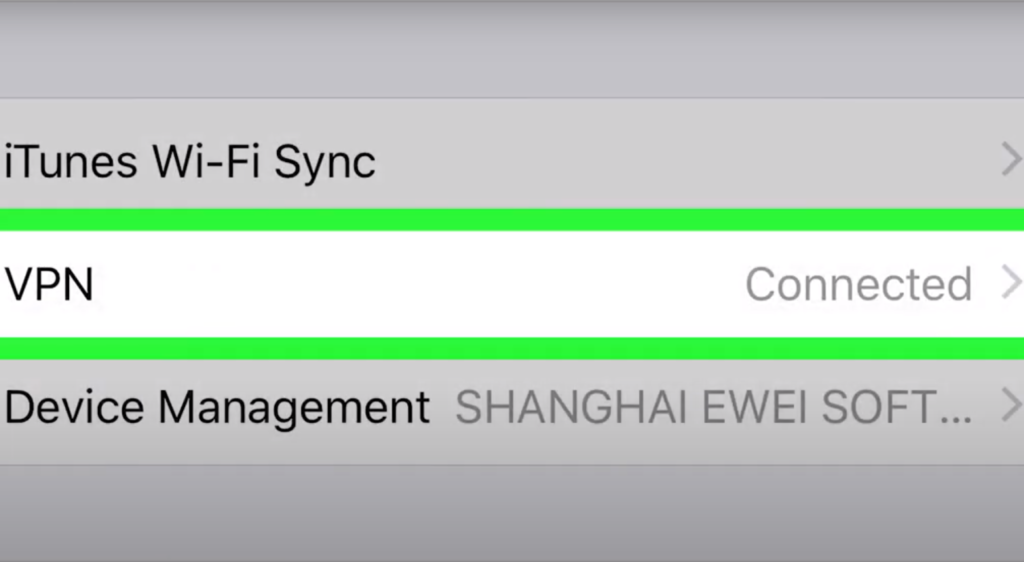
One thing to note is that not all VPN apps are created equal. Some VPN apps may have more advanced features than others, such as the ability to automatically connect to the VPN when you connect to an unsecured Wi-Fi network. Others may offer more server locations or faster connection speeds. It’s important to do your research and choose a reputable VPN app that meets your needs.
Why Change Your iPad’s VPN Address?
There are a few reasons why you may want to change your iPad’s VPN address.
Another reason to change your iPad’s VPN address is to improve your online privacy. If you’re concerned about being tracked online, using a VPN can help hide your IP address and prevent websites and advertisers from tracking your online activity. Additionally, using a VPN can help protect your sensitive information when using public Wi-Fi networks, which are often unsecured and can be easily hacked.
Finally, changing your iPad’s VPN address can help you avoid internet censorship in countries with strict online restrictions. For example, if you’re traveling to China, which has a strict online censorship policy, you can use a VPN to access blocked websites and services [2].
When Should You Turn Off VPN on iPad?
While using a VPN on an iPad can provide added security and privacy, there are times when it’s appropriate to turn off your VPN.
Here are a few situations when you may want to turn off your VPN on an iPad:
- When using a trusted network: If you’re using a Wi-Fi network that you trust, such as your home network, there may be no need to use a VPN. However, if you’re using a public Wi-Fi network, it’s always a good idea to use a VPN to protect your online activity;
- When using certain apps: Some apps may not work properly when you’re connected to a VPN. For example, some banking apps may not allow you to log in when using a VPN due to security concerns. In these cases, it may be necessary to turn off your VPN to use the app properly;
- When streaming content: While a VPN can be used to access geo-restricted content, it can also slow down your internet connection. If you’re streaming content, such as a movie or TV show, you may want to turn off your VPN to ensure that you’re getting the best streaming experience possible;
- When downloading large files: Similarly, downloading large files can be slowed down by using a VPN. If you’re downloading a large file, such as a game or a software update, you may want to turn off your VPN to speed up the download;
- When experiencing connection issues: In some cases, a VPN may cause connection issues, such as slow internet speeds or frequent disconnections. If you’re experiencing connection issues while using a VPN, it may be necessary to turn it off to troubleshoot the problem [3];
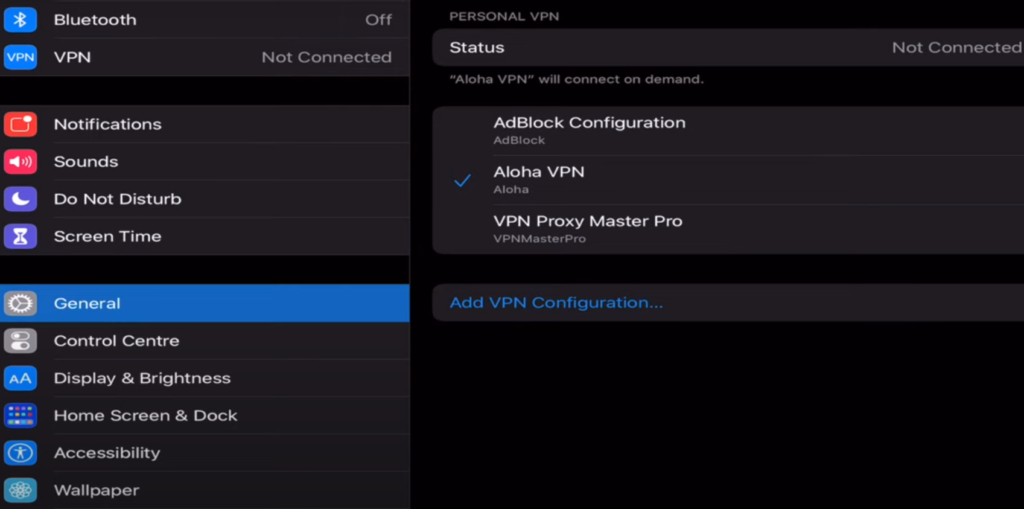
How To Turn Off VPN on iPad:
1) Using the Settings Application
The easiest way to turn off a VPN on an iPad is through the Settings application. Here are the steps to follow:
- First, open the Settings application on your iPad by tapping on the gear icon on your home screen;
- Scroll down the left-hand side of the screen until you find the option for “VPN”. Tap on it;
- You will now see the VPN configuration page, which lists all of the VPNs currently installed on your iPad. Locate the VPN you want to turn off and tap on it;
- You will now see the VPN details page. Look for the toggle switch labeled “Connect On Demand” and toggle it off. This will turn off the VPN;
- You can also toggle the switch for “Status” to off to completely disconnect from the VPN;
2) Uninstalling the VPN
If you no longer need a VPN on your iPad, you may want to uninstall it completely. Here’s how:
- Open the Settings application on your iPad;
- Tap on “General”;
- Scroll down and select “VPN”;
- On the VPN configuration page, locate the VPN you want to uninstall and tap on the blue “Delete VPN”;
- You will now be prompted to confirm that you want to delete the VPN. Tap on “Delete” to confirm;
- The VPN will now be completely uninstalled from your iPad;
3) Deleting Your VPN’s Profile
In some cases, uninstalling the VPN may not be enough. Some VPNs also create profiles on your iPad that need to be deleted separately. Here’s how to do it:
- Open the Settings application on your iPad;
- Tap on “General”;
- Scroll down and select “Profiles”;
- Locate the profile associated with your VPN and tap on it;
- Tap on “Delete Profile”;
- You will now be prompted to confirm that you want to delete the profile. Tap on “Delete” to confirm;
- The VPN profile will now be deleted from your iPad;
4) Turning Off the iCloud Relay
The iCloud Relay is a feature on the iPad that allows you to connect to other Apple devices and access their services. However, this feature can also interfere with VPN connections. Here’s how to turn it off:
- Open the Settings application on your iPad;
- Tap on “General”;
- Scroll down and select “Handoff & Suggested Apps”;
- Toggle off the switch for “Handoff”;
- Toggle off the switch for “Installed Apps” under the “Suggested Apps” section;
- Finally, toggle off the switch for “Allow Calls on Other Devices”;
With these steps, the iCloud Relay will be turned off, and you should no longer experience any interference with your VPN connection [4].
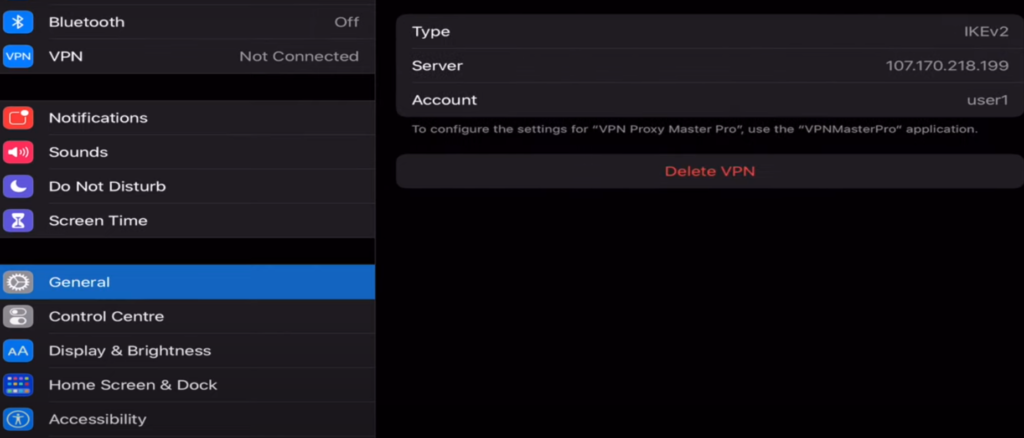
Why Can’t I Turn Off My VPN On My iPad?
VPNs are useful tools for protecting your online privacy and security, but they can also present some issues when it comes to disabling or turning them off. If you find yourself unable to turn off your VPN on your iPad, there could be several reasons for this.
Here are some of the most common reasons why you may be unable to turn off your VPN on your iPad:
- The VPN Is Set to “Always On”
Some VPNs have an option called “Always On”, which forces the VPN to stay connected even when you’re not actively using your device. This feature is often used by businesses and organizations to ensure that employees always have a secure connection to their networks. If your VPN is set to “Always On”, you won’t be able to turn it off using the Settings application.
To turn off an “Always On” VPN, you will need to contact your VPN provider or IT department and have them disable the feature for you.
- The VPN Is Managed by an MDM Profile
If your iPad is managed by a Mobile Device Management (MDM) profile, it’s possible that the VPN is being controlled by the profile. MDM profiles are often used by businesses and organizations to manage company-owned devices, and they can restrict certain features and settings on the device.
If your VPN is being controlled by an MDM profile, you won’t be able to turn it off using the Settings application. You will need to contact your IT department and have them remove the MDM profile or disable the VPN from the profile.
- The VPN Is Glitched or Has a Bug
Sometimes, VPNs can glitch or have bugs that prevent them from being turned off. This can happen if the VPN app or profile is outdated, or if there is a compatibility issue with your iPad’s operating system.
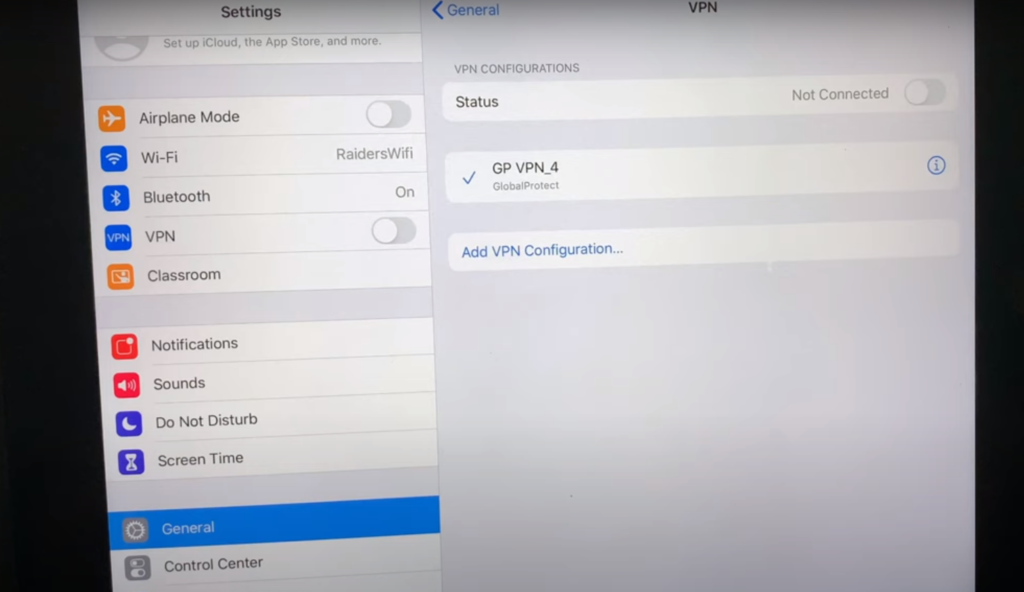
If you suspect that your VPN is glitching or has a bug, try force-closing the VPN app and restarting your iPad. If that doesn’t work, you may need to uninstall and reinstall the VPN app or profile.
- The iPad’s Network Settings Are Glitched
If your iPad’s network settings are glitched or corrupted, it could prevent you from turning off your VPN. This can happen if you’ve recently installed a new iOS update or if there’s been a system glitch.
To fix this issue, try resetting your network settings. To do this, go to Settings > General > Reset > Reset Network Settings. This will reset all of your network settings to their default values, so you’ll need to reconnect to Wi-Fi networks and reconfigure any VPN settings [5].
- The iPad Has Been Hacked or Compromised
In rare cases, an iPad may be hacked or compromised by a third party, which could prevent you from turning off your VPN. This could happen if someone gains access to your device or if you accidentally download a malicious app.
If you suspect that your iPad has been hacked or compromised, you should take immediate action to secure your device. This may include resetting your device to its factory settings, changing your passwords, and installing anti-malware software.
Turn Off The “Connect On Demand” VPN Setting:
To turn off the “Connect On Demand” setting, follow these steps:
- Go to Settings on your iPad;
- Tap on General;
- Scroll down and select VPN;
- Tap on the blue “i” icon next to the VPN you want to turn off;
- Scroll down to the “Connect On Demand” setting and toggle it off;
This should disconnect your VPN and prevent it from automatically connecting in the future.
How To Delete Your VPN App?
If you’re unable to turn off your VPN using the Settings application, you can try deleting the VPN app instead. This will remove the VPN from your iPad and should prevent it from connecting in the future.
To delete a VPN app, follow these steps:
- Press and hold the app icon on your home screen until the icons start to jiggle;
- Tap on the X icon in the upper-left corner of the app icon;
- Confirm that you want to delete the app by tapping Delete;
Note that deleting the VPN app will not delete any VPN profiles or settings that may still be on your device.
How To Delete Any Residual VPN Configuration Profiles?
If you’ve deleted your VPN app and you’re still unable to turn off your VPN, there may be residual VPN configuration profiles on your device. These profiles are created when you install a VPN app and contain settings and preferences for the VPN.
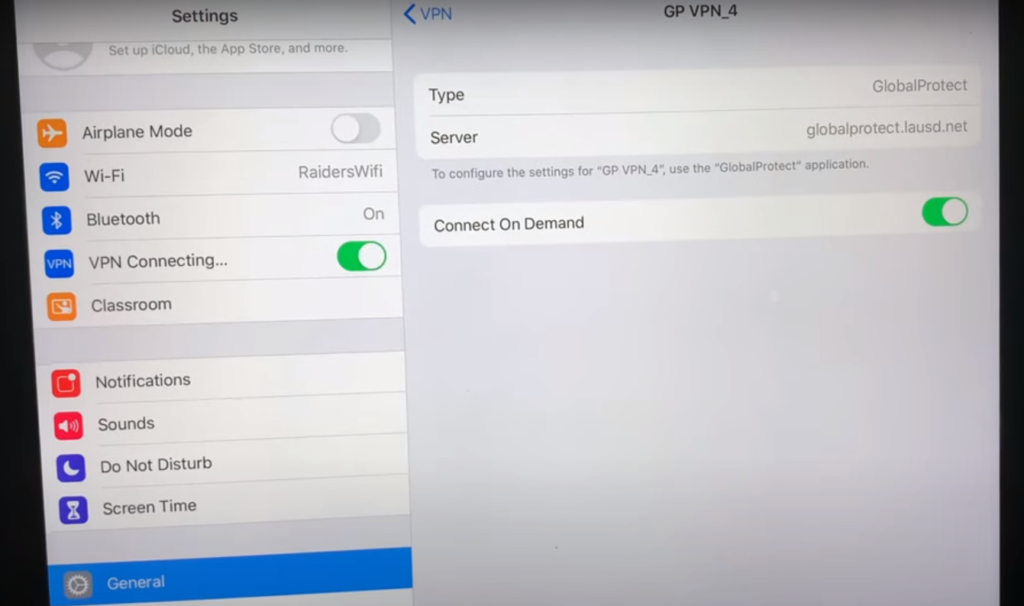
To delete any residual VPN configuration profiles, follow these steps:
- Go to Settings on your iPad;
- Tap on General;
- Scroll down and select Profiles;
- Look for any profiles related to your VPN and tap on them;
- Tap on the red Delete Profile button to remove the profile;
Note that not all VPNs create configuration profiles, so you may not see any profiles listed in this section.
How to Make Sure VPN Remains Off on iPad?
If you want to make sure that the VPN remains off on your iPad, there are a few steps you can take. First, you can disable the VPN in the settings menu. Here’s how:
- Go to the home screen of your iPad;
- Tap on the Settings icon;
- Tap on General;
- Tap on VPN;
- Tap on the VPN toggle switch to turn it off;
Alternatively, you can remove the VPN configuration from your iPad. Here’s how:
- Go to the home screen of your iPad;
- Tap on the Settings icon;
- Tap on General;
- Tap on VPN;
- Tap on the (i) icon next to the VPN configuration;
- Tap on Delete VPN;
- Confirm the deletion by tapping on Delete;
By following these steps, you can ensure that the VPN remains off on your iPad.
How to Check if VPN Has Turned Off?
If you’re not sure whether the VPN has turned off on your iPad, there are a few ways to check. Here are three methods you can use:
Method 1: Check the VPN Icon
When the VPN is turned on, an icon will appear in the status bar of your iPad. This icon looks like a small VPN symbol with the word “VPN” underneath it. To check if the VPN has turned off, simply look for this icon in the status bar. If the icon is no longer visible, the VPN has been turned off.
Method 2: Check the Settings Menu
Another way to check if the VPN has turned off is to look in the settings menu. Here’s how:
- Go to the home screen of your iPad;
- Tap on the Settings icon;
- Tap on General;
- Tap on VPN;
- Look for the toggle switch next to the VPN configuration. If the switch is in the “off” position, the VPN has been turned off;
Method 3: Test the Internet Connection
If you’re still not sure whether the VPN has turned off, you can test the internet connection. When the VPN is turned on, the IP address and location of your iPad will be different than when it is turned off.
To test the internet connection, follow these steps:
- Turn off the VPN by following the steps outlined above;
- Open a web browser on your iPad;
- Search for “What is my IP address” in the search bar;
- Note the IP address that is displayed;
- Turn the VPN back on;
- Open a web browser on your iPad;
- Search for “What is my IP address” in the search bar;
- Note the IP address that is displayed;
- If the IP address is the same in both tests, the VPN has not turned off. If the IP address is different in the second test, the VPN has been turned on [6];
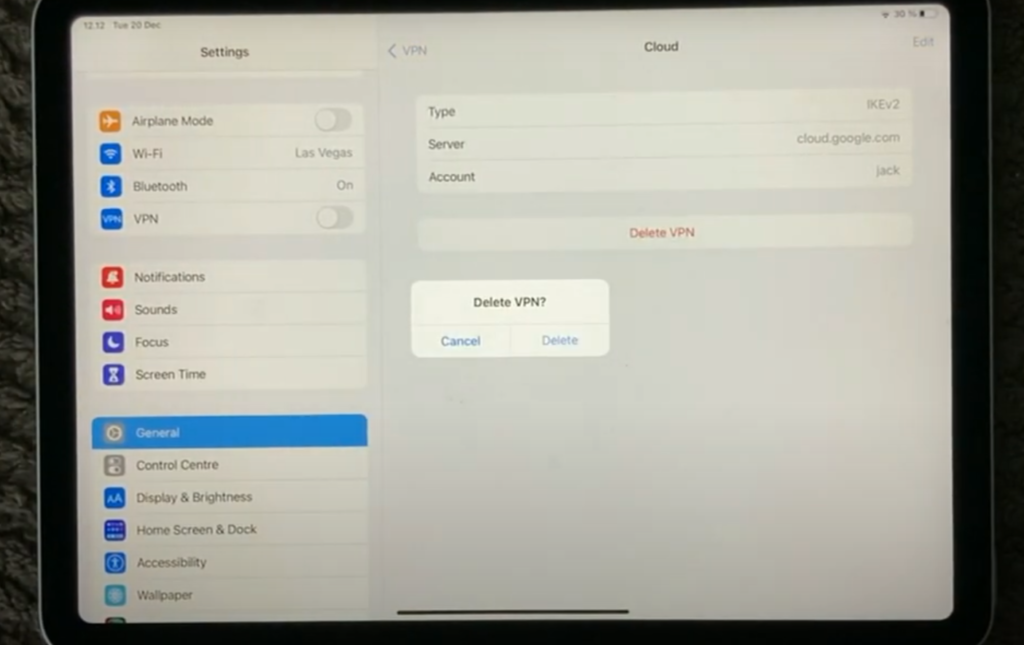
How to Resolve Most VPN Issues:
Reset the Network Settings
One of the most common reasons for VPN issues is a problem with the network settings. This can occur when the network settings have been altered or corrupted, preventing the VPN from working properly. Fortunately, resetting the network settings is a simple and effective way to resolve this issue.
To reset the network settings on a Windows computer, follow these steps:
- Open the Start menu and click on Settings;
- Click on Network & Internet;
- Click on Status;
- Click on Network reset;
- Click on Reset now;
- Follow the on-screen instructions to complete the reset;
To reset the network settings on a Mac computer, follow these steps:
- Click on the Apple menu and select System Preferences;
- Click on Network;
- Select the network connection that is experiencing issues;
- Click on the minus sign (-) to remove the connection;
- Click on the plus sign (+) to add the connection back;
- Follow the on-screen instructions to complete the reset;
- Once the network settings have been reset, try reconnecting to the VPN to see if the issue has been resolved;
Change Server Locations
Another common reason for VPN issues is a problem with the server location. If the server you are connecting to is experiencing high traffic or is located in a region with strict internet censorship, you may experience issues with your VPN connection. To resolve this issue, try changing the server location.
Most VPNs offer a variety of server locations to choose from. To change the server location, simply select a different server from the list of available options. This can typically be done within the VPN app or client.
When selecting a new server location, it is important to choose a location that is geographically close to your actual location. This will help to ensure a faster and more stable connection. Additionally, it is important to choose a server location that is not experiencing high traffic or internet censorship.
Check for VPN Updates
Finally, if you are experiencing VPN issues, it is important to check for updates to the VPN software.
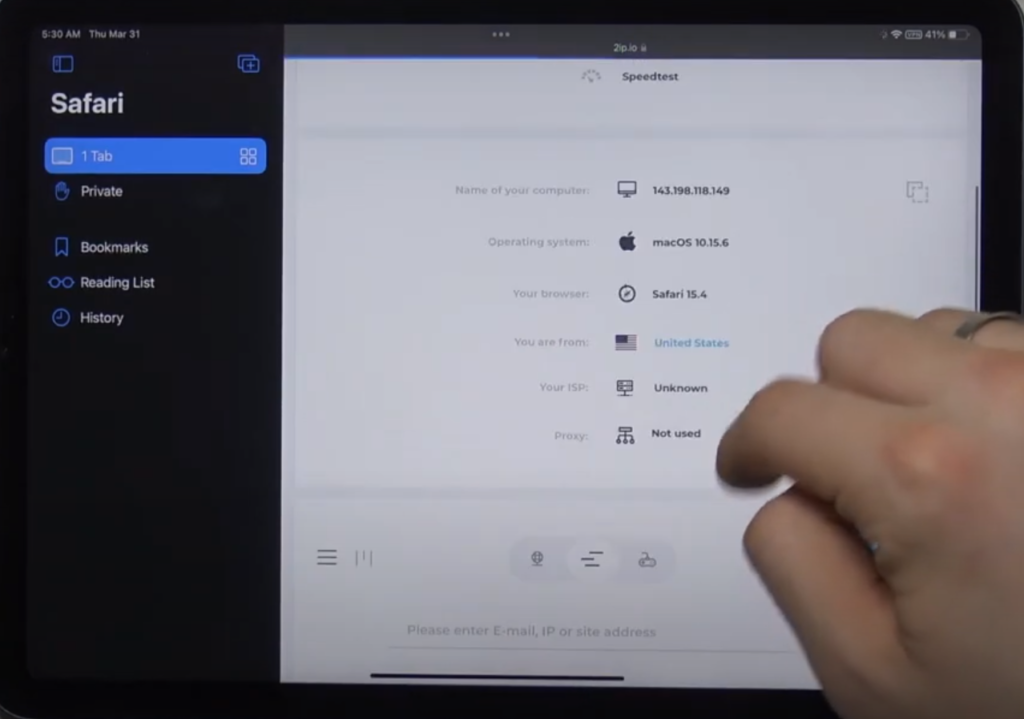
In addition to checking for updates to the VPN software, it is also important to keep your operating system and other software up to date. This can help to prevent conflicts or compatibility issues that may impact the performance of the VPN.
FAQ:
- Why can’t I turn VPN off on my iPad?
There could be several reasons why you may not be able to turn off VPN on your iPad. One common reason is that you may not have administrative access to the device or the VPN connection. If the VPN connection is managed by a company or organization, it may be set up to require permission from the administrator to disable it. Another reason could be that the VPN app itself is malfunctioning or has a bug that is preventing you from turning it off.
- Where is the VPN setting on iPad?
To access VPN settings on an iPad, go to the Settings app and tap on the “General” option. From there, select “VPN” and you will be able to view and configure VPN settings.
- Should VPN be turned on on my iPad?
Whether or not to use a VPN on your iPad depends on your specific needs and security concerns. If you frequently use public Wi-Fi networks, travel to countries with restricted internet access, or need to access content that is blocked in your location, using a VPN can help protect your privacy and secure your internet connection. However, if you primarily use your iPad on a trusted private network, you may not need to use a VPN.
- What is the VPN button on iPad?
The VPN button on an iPad is a toggle switch that allows you to turn VPN on or off quickly. It is located in the “General” settings, under the “VPN” section [7].
- Why have I got VPN on my iPad?
If you have a VPN on your iPad, it is likely because you or someone with access to your device has installed a VPN app or configured a VPN connection. VPNs are commonly used for privacy and security reasons, as they can encrypt your internet traffic and protect your online activities from prying eyes.
- How do I stop my VPN from automatically turning on?
To stop your VPN from automatically turning on, you will need to disable the “Connect On Demand” option in the VPN settings. This option allows the VPN to automatically connect when certain conditions are met, such as when you connect to an unsecured Wi-Fi network. By turning off this option, you can manually control when the VPN connection is established.
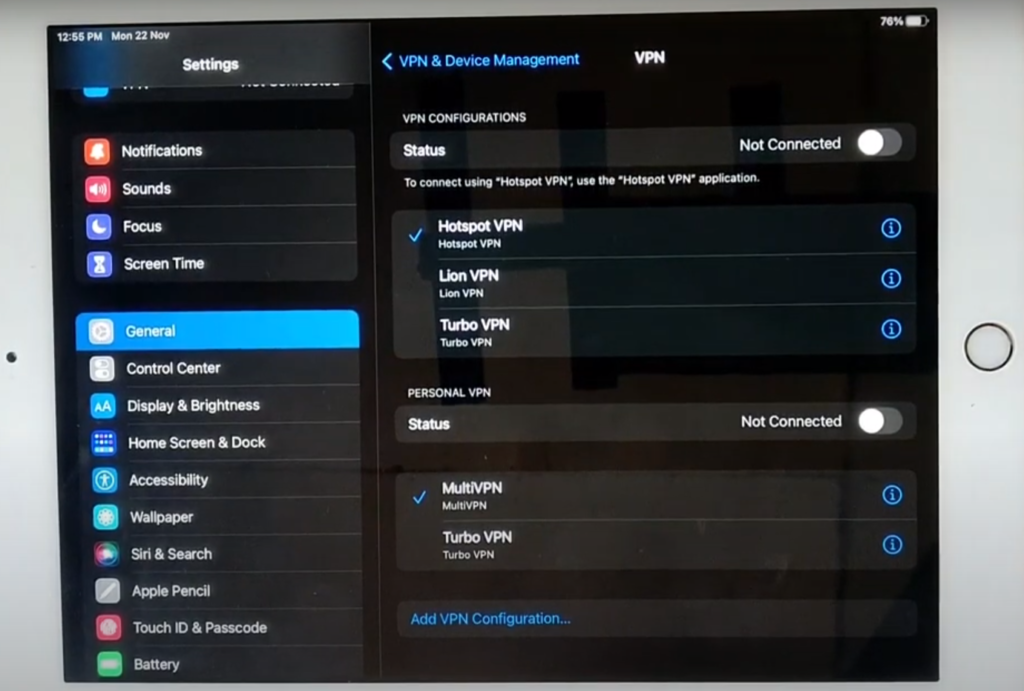
- How do I turn off VPN on iOS?
To turn off VPN on iOS, go to the “General” settings and select “VPN”. Then, toggle the VPN button to the “off” position.
- How do I remove VPN and Device Manager from my iPad?
To remove a VPN or Device Manager from your iPad, go to the “Settings” app and select “General.” From there, select “Profiles & Device Management” and locate the profile or device manager you want to remove. Tap on it, and then select “Delete Profile” to remove it from your device.
- Does iPad have a built-in VPN?
The iPad does not have a built-in VPN, but it does have support for VPN connections. You can either use a third-party VPN app or configure a VPN connection manually in the settings.
- What is VPN in iOS settings?
The VPN settings in iOS allow you to configure and manage VPN connections on your device. From this section, you can add, edit, and remove VPN connections, as well as toggle the VPN on or off.
- Does Apple have a built-in VPN?
Apple does not have a built-in VPN, but it does offer support for VPN connections through its iOS operating system. This means that you can use a third-party VPN app or configure a VPN connection manually in the settings.
- How do you check if I am connected to a VPN?
To check if you are connected to a VPN on an iPad, go to the “Settings” app and select “General.” Then, select “VPN” and look for the status of your VPN connection. If you see the word “Connected” next to your VPN connection, then you are currently connected to the VPN.
- What happens if VPN is on all the time?
If you have VPN on all the time, it can provide a more secure internet connection by encrypting your traffic and protecting your online activities from prying eyes. However, it can also slow down your internet speed and may cause issues with certain apps or websites that are not compatible with VPN connections.
- How do I block VPN on my Wi-Fi?
To block VPN on your Wi-Fi network, you will need to access your router’s settings and configure it to block VPN traffic. The specific steps for doing this will depend on your router’s make and model, so it’s best to consult the user manual or contact the manufacturer for assistance.
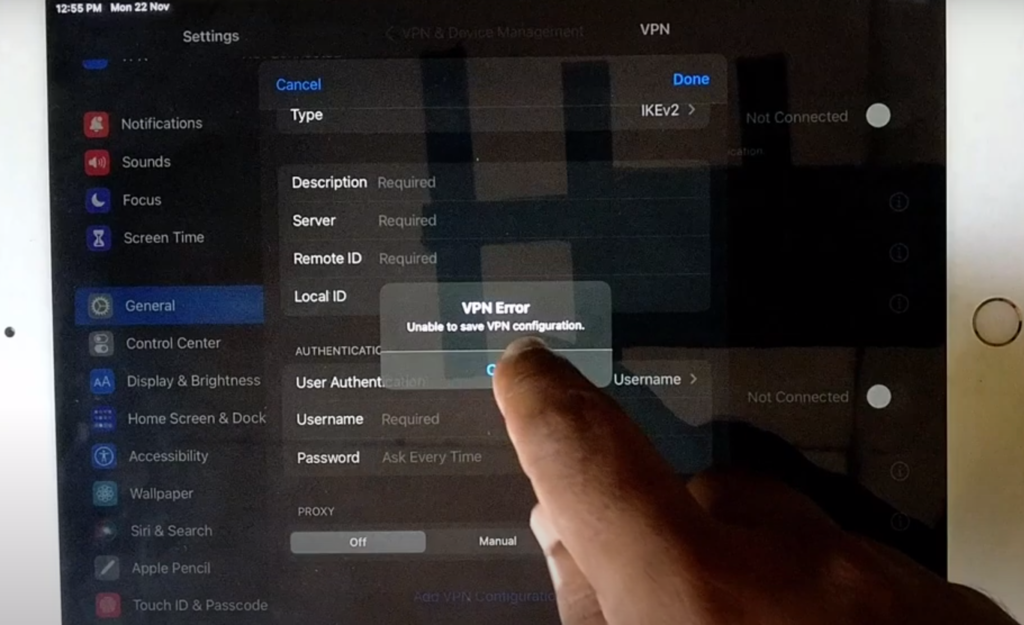
- Can VPN disconnect Wi-Fi?
No, VPN should not disconnect Wi-Fi. VPN relies on an active internet connection to function properly. However, if you are experiencing issues with your Wi-Fi connection while using VPN, it could be due to several factors, such as a weak signal or interference.
- Why should you not always use a VPN?
While VPN can provide additional privacy and security when browsing the internet, it may not always be necessary or practical to use one. VPN can slow down your internet speed and may cause issues with certain apps or websites that are not compatible with VPN connections. Additionally, using a VPN can sometimes raise suspicions or trigger security measures, especially when accessing sensitive or restricted content.
- How do I remove VPN from iOS 15?
To remove VPN from iOS 15, go to the “Settings” app and select “General”. Then, select “VPN” and tap on the VPN connection you want to remove. From there, select “Delete VPN” to remove it from your device [8].
Useful Video: How to Disable VPN on iPad
References:
- https://www.wiredtitan.com/how-to-turn-off-vpn-on-ipad/
- https://devicetests.com/how-to-turn-off-vpn-on-ipad
- https://www.nstec.com/why-can-t-i-turn-off-vpn-on-my-ipad/
- https://www.macworld.com/article/673073/how-to-use-a-vpn-on-an-iphone-or-ipad.html
- https://osxdaily.com/2019/12/14/how-delete-vpn-iphone-ipad/
- https://vpnwrites.com/how-to-turn-off-vpn-on-ipad/
- https://www.imore.com/how-configure-vpn-access-your-iphone-or-ipad
- https://www.idownloadblog.com/2022/10/06/fix-vpn-not-working-iphone/






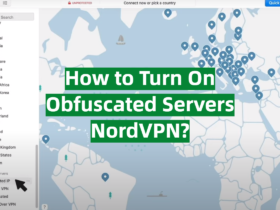

Leave a Reply